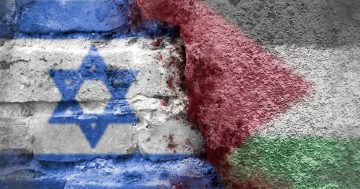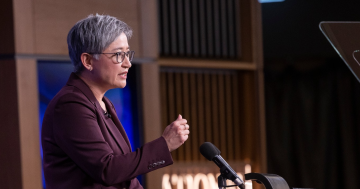
The bloodshed in Israel and Gaza is pouring out of our TV screens every night. Photo: Yuliia Bukovska.
I can’t watch the nightly gorefest that the TV coverage of Gaza has become.
The sight of bloodied children every night and the roll call of testimonials about the loss of entire families doesn’t make me more informed or understanding of the conflict.
I know war is hell, dehumanising and the enemy of truth.
I know if it bleeds it leads, particularly in pictures-driven television news.
I know we shouldn’t hide ourselves away from what is happening in the world, especially as journalists.
But the parade of horrors on my screen has just become voyeuristic voyages across the smoking ruins of people’s lives with little information or facts to leaven the experience, just a warning that these images may distress.
The interviews with mothers and fathers wild with grief, their dead children beside them, may well be “real human stories” but at what point do we acknowledge that this immersive journalism is unhealthy, that sitting comfortably in the armchair of a living room in Canberra watching the unspeakable night after night does nobody any good.
I’m not the only one. Veteran UK newsman and Guardian columnist Simon Jenkins came to the same conclusion, slamming television news for descending into exploitative emotional manipulation.
“This is tabloid television, offering a ghoulish gloss on what news should be about, which is facts and their informed interpretation. Yet it is assumed that we cannot handle this, and instead are given endless vox pops with people on the ground. We need something to stir the emotions,” he wrote recently.
He admits he is feeling better for not watching the news, and I can concur.
It doesn’t mean we don’t care, or aren’t interested, but will we be better informed at the end of the bulletin?
Probably not, and I just don’t need to watch torturous close-ups of suffering to understand their pain.
There was a time when newsrooms had serious debates about showing such images, particularly for TV at that time of the day, but now it seems anything goes.
But this is not simulated Netflix violence but war in all its unforgiving brutality.
The awful thing about this conflict is that it is but the latest chapter in the interminable violence in the Holy Land, and a solution seems as far off as ever.
The nature of Hamas’s murderous and barbaric attack on Israel does set this round apart but it has only harvested an even deadlier response, and we are being asked to decide the impossible – which lives are more valuable.
Is it anti-Semitic to question the civilian death toll in Gaza?
Is it anti-Palestine to support Israel’s right to defend itself and to condemn an organisation that would expose its own people to such agony and openly want Israel’s destruction?
One of the more interesting and little-reported facts about Hamas is that one of its biggest supporters was Israeli PM Benjamin Netanyahu, who helped keep it strong to pursue a divide-and-rule policy against the Palestinians and undermine any hope of a two-state solution.
There are those on both sides who can’t abide by any notion of peaceful coexistence.
The danger is that while Hamas may be defeated, out of the fire will be forged a new enemy, its ranks filled by another generation of angry young men with nothing to lose.
I don’t pretend to have all the answers but I do know that I won’t find them looking at relentless pictures of death.
















